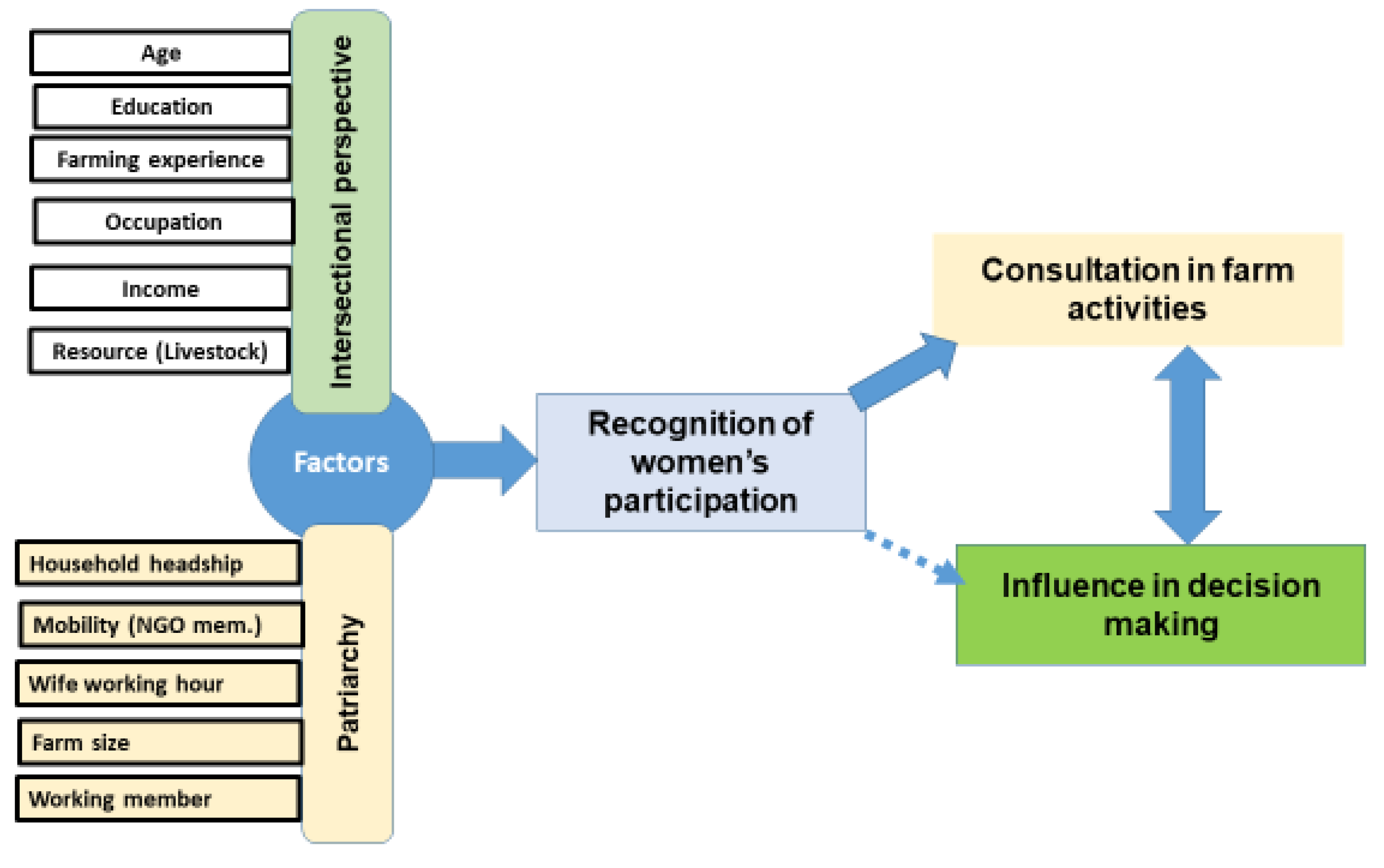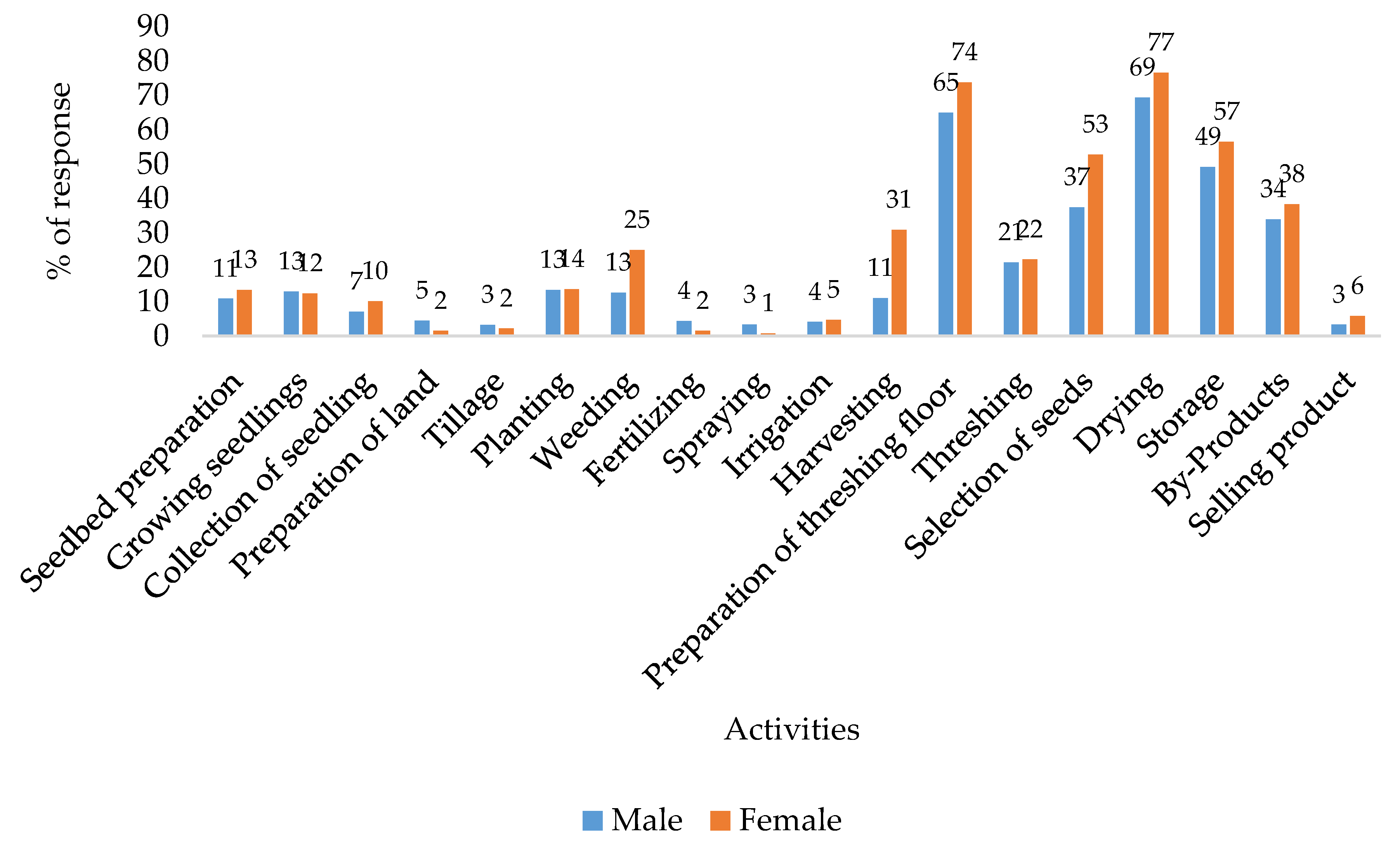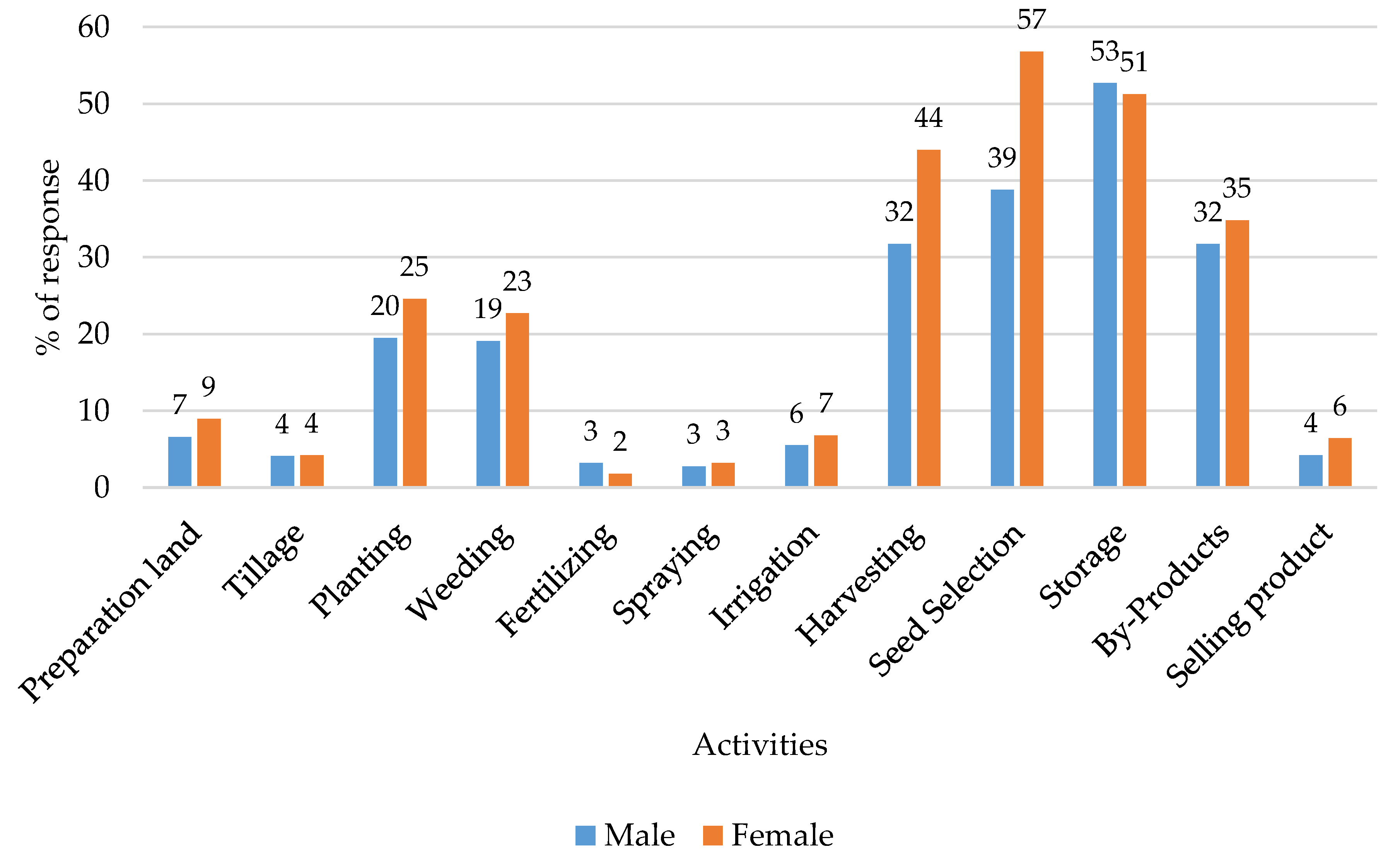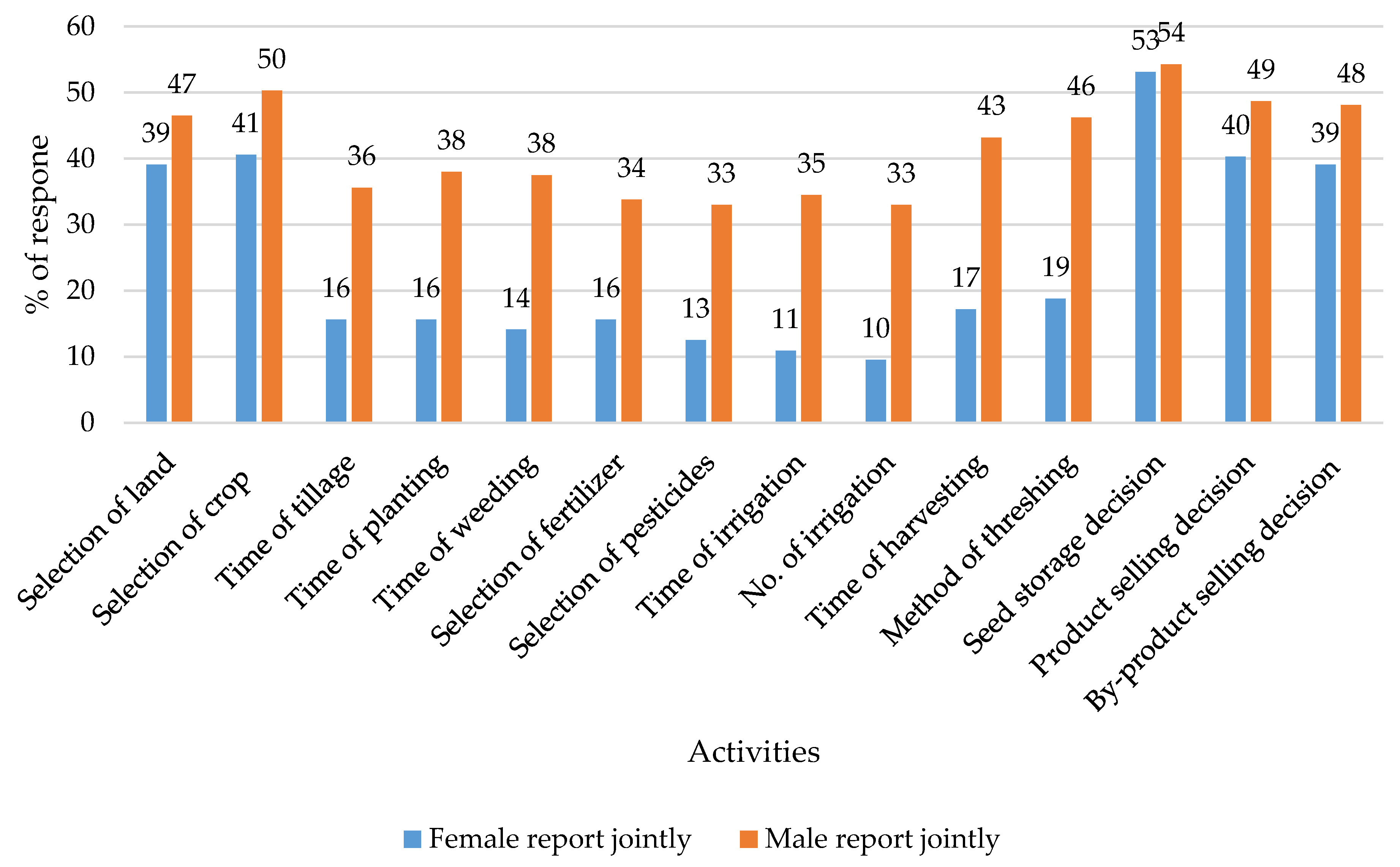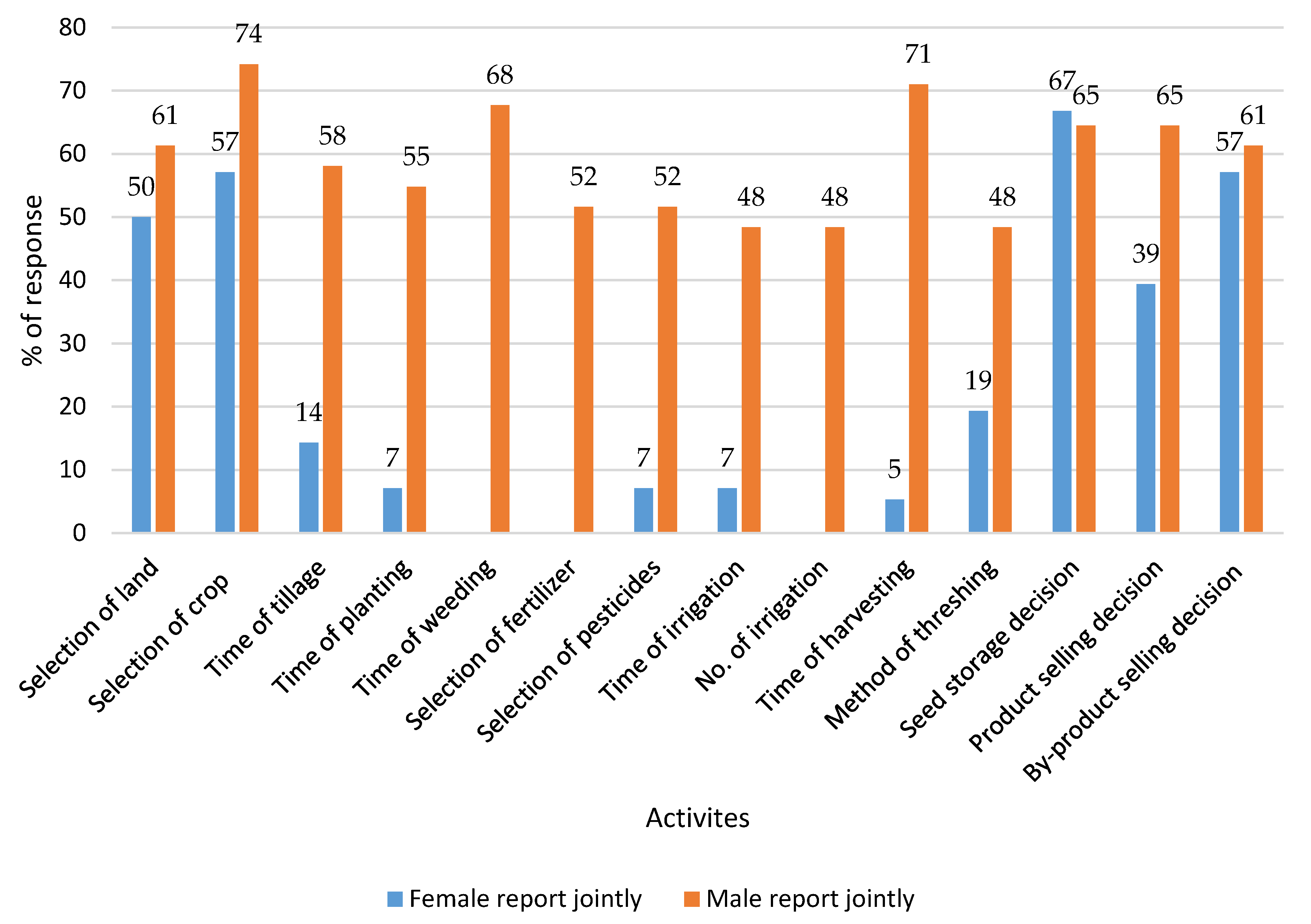1. Introduction
Bangladesh has made remarkable progress in its agriculture sector despite decreasing arable land, population growth, and adverse climatic effects [
1]. The agriculture sector contributes 13.31% of GDP (Gross Domestic Product), provides employment for around 40% of the total labor force, and feeds about 164.6 million of its population [
2,
3]. In fact, the country has one of the lowest land–person ratios in the world, estimated at 0.088 ha per person [
3]. The number of agricultural farm households is estimated at 1.66 million, which accounts for 46.61% of total households [
4]. There is huge pressure on the land to produce more crops to ensure self-sufficiency in food. To attain this self-sufficiency, the government has designed and implemented various agricultural policies for expansion of irrigation facilities, production and distribution of high-yielding-variety seeds, and other inputs [
1,
5,
6]. Availability of irrigation has been the most significant contributor to being able to grow crops year-round and increase crop productivity in the northwest region [
7], where over 97% of the total area uses groundwater irrigation [
8]. The Barind Multipurpose Development Authority has been operating 15,553 deep tubewells (DTWs) and 519 Low Lift Pumps (LLPs) in the northwest region [
9]. The Bangladesh Agriculture Development Corporation (BADC) and Rural Development Academy (RDA) have also installed a good number of DTWs. In addition, quite a large number of shallow tubewells (STWs) are being operated by individuals [
10,
11] to assist in growing dry-season crops. The northwest region had the highest percentage (85%) of net cultivable area irrigated during 2012–2013, followed by the northcentral region (73%) and southeast and southwest regions (45%) [
12]. The northwest region is one of the major crop production areas, and supplies about 35% of the irrigated Boro rice and about 60% of the wheat of the whole country [
8,
13]. Dry-season crops, such as Boro rice, wheat, maize, potato, pulses, and winter vegetables, are the main contributors to ensuring food security at household, regional, and national levels. Like men, women are involved in crop production as farmers, co-farmers, farm managers, and wage laborers. Labour Force Survey [
2] estimated that, by 2016–2017, female-headed households in rural Bangladesh had increased by 13.8%, implying that women are taking more responsibility in farming and household activities. By 2015, women’s participation as agriculture wage laborers had also increased by 11.02% from 3.1% in 2000 due to male out-migration and male participation in non-farm activities [
2]. In the absence of male members, the women’s role is changing from unpaid family worker to farm manager, a phenomenon termed as the “feminization of agriculture” [
14].
Nevertheless, there are significant variations in the roles of men and women and their statuses in agriculture. Women comprise about 43% of the agricultural labor force in developing countries, ranging from around 20% in Latin America to 50% in parts of Africa and Asia, and exceed 60% in a few countries [
15]. In Bangladesh, about 49% of women were engaged in the agricultural sector (including forestry and fisheries) in 2016–2017 [
2]. Despite their substantial role in agronomic activities, women are not addressed by agricultural research and extension services [
16]. Generally, women are extensively involved but “largely unrecognized” [
17]. They are more likely to be in agricultural employment than men [
18], but are associated with specific operations and crops. Women usually work on a smaller scale, employing traditional tools and techniques to grow food for their families and the local market. For example, whereas rice cultivation is male-dominated, women play an important role in the production of high-value crops, such as vegetables [
19]. With respect to “male” crops and “female” crops, there are many settings where such distinctive gendered cropping patterns do not apply. In Ghana, women are involved in the production of all major crops [
20]. Crop preference depends on the socioeconomic situation and livelihood strategy of the household, rather than a mere distinction based on the gender of the farmer or household head [
21]. Evidence from Mozambique and Kenya shows that women plot managers grow fewer crops and fewer cash crops (than male plot managers) [
22,
23].
It is argued that women often provide all of the farm labor when their spouse/partner is away from the farm, they feed farm laborers, and frequently provide managerial input and advice. However, statistics do not tend to record the full range of farm work undertaken by women, and for this reason, women’s involvement in farming is systematically under-reported [
24]. In fact, it is difficult to disaggregate men’s and women’s contributions either in terms of labor supplied or in terms of output produced; however, where women farmers have equal access to the same resources, their farms are as productive as those run by men [
25]. An empirical study in Ethiopia reported that maize productivity of male-headed households was overall 44.3% higher than that of female-headed households, but it was almost equal at 42.3% (gap only 2.0%) when they received the same productive resources, such as secure tenure, livestock, and agricultural machinery [
26]. Similarly, FAO [
27] report that “if women had the same access to productive resources as men, they could increase yields on their farms by 20–30 percent.” In fact, women farmers do not have equal access to productive resources, and this significantly limits their potential to enhance productivity [
28].
Previous studies on gender and agriculture tend to focus on documenting the efficiency and productivity differences between male- and female-headed households and empowerment (e.g., [
29,
30,
31,
32,
33,
34,
35]). Other literature looked into gender norms that are embedded in existing structural and institutional conditions, noting that women and men use their agency to assert, resist, and renegotiate gender norms to varying degrees in their everyday lives [
36,
37,
38,
39]. In practice, women and men can and often do behave in ways that stretch and reshape prevailing cultural norms about gender [
40,
41]. Encouragingly, gender roles and norms in agriculture are changing [
42,
43], and enhancing women’s involvement in agriculture is an important strategy for reducing poverty and improving food security. The National Agricultural Policy [
44] and the National Strategy for Accelerated Poverty Reduction (2009–2011) outline commitments to ensuring that women have access to agricultural extension, productive resources, inputs, and services to achieve sustainable farming [
45]. Failure to recognize the roles, differences, and inequalities poses a serious threat to the effectiveness of the agricultural development agenda [
16]. In fact, secure tenure, information, and other complementary resources are needed for both men and women to achieve sustainable food security [
46]. High levels of inequality make it harder to increase productivity and reduce poverty and hunger [
47]. Addressing gender relations in farming is essential to achieving sustainability in agriculture [
48]. Hence, documentation of women’s involvement in farming and their participation in on-farm decision-making is crucial for future policy interventions. However, there has been scant attention given to documenting intra-household participation in farm activities and men’s views of women’s contribution to farming. The few studies reported in the literature show that women are extensively involved in farming, but are not recognized equally [
17,
49]. To date, there are no similar empirical studies in Bangladesh. Therefore, this paper aims to address two research questions: (i) Do men in Bangladesh recognize the contributions of women and men in farm activities equally? (ii) What are the factors that influence men to consult with their spouses/partners in farm decisions?
The article begins with the conceptual and methodological framework used to evaluate the growing participation of women in farming activities in dominantly masculine roles in rural Bangladesh. It presents the different perceptions of women’s contribution to rice and vegetable production cycles, decision-making status and determinants of consultation, decision-making status in farming, and, finally, intra-household division of daily working hours. The article provides a new insight into how family dynamics are changing in recognizing women’s contributions in crop farming. This knowledge can then be translated directly into more equitable policy interventions.
2. Conceptual Framework for Recognizing Women’s Participation
The study incorporates concepts of patriarchy and masculinity [
50] with an intersectional perspective [
51] to analyze men’s views of women’s involvement in farming and on-farm decision-making. According to the assumptions of patriarchy and patriarchal masculinity, men may dominate and abuse their wives to maintain their “standard masculine supremacy”, as reflected in male guardianship endorsed by patriarchal norms/ideologies [
52]. As a sociocultural theory, the concept of patriarchy helps elucidate how patriarchal social order constructs a dominant masculinity that is reflected in men’s views of women’s involvement in farming. Similarly, the intersectionality lens focuses on how masculine identities perform inside the households and express themselves to outsiders. Intersectional perspectives use an analytical and methodological framework to examine the multiple interacting effects (shown in
Figure 1) of identity and historical oppression in institutional structures. For example, a man may feel discomfort in disclosing his attitude/behavior towards his wife to outsiders due to social structures and institutional norms. Both patriarchal and an intersectional perspectives have been integrated to address the perceptions of men and women in women’s involvement in farming and decisions at farm and household cohorts, as portrayed in
Figure 1. In fact, patriarchal and intersectional perspectives offer methodological tools that support the development of gender research through in-depth attention to both the heterogeneity of effects and causal processes producing gender inequalities.
Gender norms in Bangladesh are rooted in its patrilineal norms, which impose restrictions on women’s access to productive resources (land ownership—farm size is used due to the lack of gender-specific land ownership data), making decisions (household headship), and mobility (outside households), which is crucial for engagement in crop farming [
53]. Despite societal norms, a significant portion of women are involved in farming as unpaid family workers [
54]. The intersectional perspective varies based on masculine identities, including age, education (years of schooling of wife), farming experience, occupation, income, and resources (see
Figure 1). As shown in the diagram, both patriarchal (household headship, mobility, wife working hour, farm size, working member) and intersectional perspectives influence men’s views in recognizing women’s contributions in farming, which leads to consultation between them. Taking these factors into account, the framework conceptualizes that including women in consultation processes may result in women having influence in the decision-making. This concept is tested by adopting an econometric logistic regression model.
3. Materials and Methods
The strategic objective of the Bangladesh Second Country Investment Plan (2016–2020) is to ensure availability, affordability, and nutritional quality of foods and that all people have access to a variety of safe and nutritious foods, as well as knowledge to be able to make healthy diet choices [
55]. To attain the objective, proper attention is required for the agriculture sector, particularly for smallholder agriculture. Like other parts of the country, the northwest region is dominated by a large number of smallholders traditionally engaged in rice and vegetable cultivation [
56]. In fact, the region has comparatively limited employment opportunities from other economic sectors, such as trade, services, and industries. Hence, a second crop diversification initiative (introduction of high-value crops, including vegetables) has been widely adopted by the farming community [
56]. Among crop diversification project beneficiaries, 57% (141,462 women) were women who received training for cultivation and marketing of high-value crops in groups using modern technologies [
57]. Women in the northwest region are much more involved and visible in agriculture than those in the southeast regions of Bangladesh [
58]. Thus, assessment of gender-specific participation in crop and vegetable production cycles is important for ensuring availability, affordability, and nutritional quality of foods.
In this circumstance, data were collected from five districts, namely Rajshahi, Chapainawabganj, Bogura, Dinajpur, and Nilphamari of the northwest region of Bangladesh. The selected districts represent northwest Bangladesh, as they are dispersed across the region and represent the areas with high, medium, and low available groundwater. Both qualitative and quantitative approaches were adopted for generating the evidence. A randomly selected sample of 240 farming community households were interviewed, with the man (husband) and the woman (wife) interviewed separately. However, all respondents were selected from the farming community as a prerequisite, considering the nature of the study. A pre-tested questionnaire was used to collect data by the trained enumerators in 2018 with strong supervision by the researcher. Most of the recruited enumerators were female graduate students of Bangladesh Agricultural University in order to enable greater accessibility to the women participants (females interviewing females). Before beginning the interview, enumerators provided a brief description about the nature and purpose of the study to the participants. After taking consent, questions were asked in a simple manner, and explanations provided wherever necessary. The information supplied by the interviewees was recorded directly in the interview schedule. Interviewees were requested to provide reliable information as much as possible. The information was checked carefully (for omissions) before leaving the study area.
For qualitative surveys, it is important to triangulate the results and clarify where different responses were obtained—for this, focus group discussions (FGDs) were conducted until new information was generated, i.e., information was saturated in all selected areas. After collection, necessary and relevant data and information were digitized (into spreadsheets), scrutinized, and analyzed based on the research questions set for this study. Data were analyzed using IBM SPSS Version 20. Its tabular method was applied because it is simple in calculation, widely used, and easy to understand. Independent t-tests were performed to document the different views of the respondents. The independent sample t-test compares two independent groups of observations or measurements on a single characteristic. Five categories—strong, high, moderate, weak, and none—were used to measure the extent of participation for each activity, where strong implies the highest level (100%) of participation, and none implies no involvement (0%). These data were collected based on the percentage of men and women involved in each activity in the crop production cycles. The percentage data are further explained in
Table 1.
4. Specification of Econometric Analysis
Based on the patriarchal and intersectional perspectives, several determinants have been identified (through literature reviews) that might influence men to discuss or consult with their counterparts before making final farm decisions. To identify which (and how many) of these determinants are relevant in the context of northwest Bangladesh, a logistic regression econometric model has been adopted. Logistic regression is used widely to examine and describe the relationship between a binary response variable (jointly decided or alone) and a set of predictor variables [
59]. In order to explain the behavior of a binary (dichotomous) dependent variable, two scenarios were used—(i) husband decides alone, and (ii) husband decides jointly with the wife. The response variable
is
binary; that is, it can have only one of two possible outcomes, denoted as 1 (joint decision) and 0 (alone decision) based on the quantitative survey results. The outcome variable (
was thought to be influenced by the independent variables (
). It was assumed that the model takes the form
where
Pr denotes the probability, and
is the function of the standard normal distribution. The parameter
is typically estimated by maximum likelihood. It is also possible to motivate the logit model as a latent variable model. Suppose there exists an auxiliary random variable,
where
wi ~
N(0, 1). Then,
Z can be viewed as an indicator of whether it is a latent variable and positive:
The main difference between logit and probit regression models is that the logit has slightly flatter tails, i.e., the normal or probit curve approaches the axes more quickly than the logit curve. Qualitatively, while logit and probit regression models give similar results, their parameter estimates are not directly comparable. The choice between the logit and probit models is largely one of convenience and convention, since the substantive results are generally indistinguishable. Hence, an empirical logit model was developed to determine the factors that significantly increase the probability that a husband will consult with his wife:
where T
i = Husband consults with wife, or not, in farming decision,
Intercept,
Explanatory variables,
Coefficient of determinants, and
Error term.
The explanatory variables considered in the logit model are as set out in the framework described in
Figure 1:
X1 = Age of respondent (years), X2 = Wife’s education (years of schooling), X3 = Farming experience (years), X4 = Main occupation (farming = 1; otherwise =0), X5 = Family income (Tk/year), X6 = Number of livestock and poultry, X7 = Household headship (female = 1; otherwise = 0), X8 = Non-governmental Organization membership (female = 1; otherwise =0), X9 = Wife’s time allocation in farming (hours), X10 = Farm size (decimal), and X11 = Number of working members in the family.
6. Conclusions
This paper verifies the statement that “women contribute greatly to growing crops year-round, but are not recognized” through in-depth empirical investigation in Northwest Bangladesh. The responses were collected from husbands and wives regarding their participation in farm and household activities and decision-making. In some tasks, the results report statistically significant disagreement between husbands and wives on the females’ participation in activities in rice and vegetable production cycles. Despite the growing involvement of women in farm activities, rural women get recognition for their household activities, but not for their agricultural activities. In fact, men felt discomfort in admitting their wives’ influence on farm decisions due to social norms. The assertion that women’s growing involvement in farming is not equally recognized by husbands is validated through independent t-tests in the study areas. This finding can be interpreted in that society will take a longer time to recognize women’s contributions in farming if husbands do not come forward to recognize their wives’ roles in farming.
Usually, males are responsible for crop production and protection of family assets, and also for making all household and family decisions, while females manage the household, take care of the family members, and manage the homestead garden. Both husbands and wives reported that most household decisions are made jointly, which is similar to results in other south and east Asian countries. While both make decisions on household matters, females spent more hours for cooking, cleaning, child caring, livestock rearing, and leisure periods. Females spent an average of 5.39 hours/day, while their male counterparts spent an average of 0.63 hours/day in household work. The males enjoyed more leisure time than females, and also spent more time participating in social/community work. This finding reinforces the general notion that in developing countries like Bangladesh, women are mostly confined to the household activities, while men are responsible for all outside tasks.
Decision-making processes are not uniform across households—rather, they depend on the patriarchal and intersectional perspectives perceived by the household. Explicitly, four intersectional (age, wife education, income, and livestock number) and two patriarchal (NGO membership and time allocation in farming) factors report significant likelihood that the husband would consult with his spouse (wife) when making decisions. Women who spend more hours in farm activities are associated with more involvement in farm-related decision-making processes. More importantly, women who are educated and have NGO membership have a higher opportunity to participate in the decision-making process and to be able to influence the decisions. Bangladeshi NGOs offer diverse programs (credit, savings, and social services) for women (mostly) that encourage women to participate in income-generating activities and to contribute to their families. Hence, participation in NGO activities and education (years of schooling) might create a provision for women to contribute in farm and household decisions.
The article provides a new insight of family dynamics in recognizing women’s contributions in farming. The use of intersectional and patriarchal perspectives to identify factors that impact the likelihood of women participating in farm and household decision-making processes can be regarded as a unique contribution to future gender research. The incorporation of both husbands’ and wives’ perspectives in the analysis and interpretation of results is not common practice and has provided great insight. This has greater policy implications. This evidence can inform future agricultural policy interventions designed to recognize the role that women play in agricultural production, and can effect gender integration into crop farming in Bangladesh in line with promoting women’s education and NGO membership.
